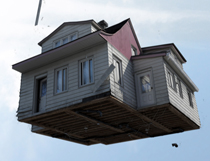T.B.: How does it feel? That’s interesting. It often begins by listening, sensing and discovering a mania that is already in the ground. The feeling is that I am mad for thinking I am doing this so that when the mania reveals itself I have a euphoria (a mad/not mad blend). So – listening (me) sensing (less me) mania (not me ) feeling mad (looking back at me) euphoria (me as the greater feeling). There has to be a harmony, a tuning of these elements – that is, they have to stay distinct but combined, so that different notes, tones will play different conflicts. I apologise for the music analogy, but it fits this a bit. Sound and noise. That way every word has access to a specific ambivalence – and as words accumulate, each with its specific ambivalence, you listen for how they want to occupy, infect, destroy, (pick an action) the conventional content (the story words are supposed to support) and you wait, listening again, because you have a spiritual copy of the ground now, so you can repeat the process with this new version. This can be done infinitely and in fact, what you are listening for now is to isolate a part (it should be a brief, obscure part, a behaviour even, something infra mince) that does something transformative to you (not to the story but to you after the story and not because you `see the world differently’ but because you can’t see the world `properly’ at all)
I’m aware that it’s grandiose and deluded (what a writer denies or avoids) but it takes grandiosity and delusion – wretched grandiosity and catastrophic delusion – to write. A lot of these ideas originate for me in early modern theories of rhetoric, occulted neo-Socratics, like John Dee, Giordano Bruno, Petrus Ramus and best realized in someone like Christopher Marlowe.
K.K.: Have you read The Spell of The Sensuous by David Abram? He writes in this book about the emergence of words from nature, and many times while reading your work his words came to mind. I am reading his new book Becoming Animal, and in it he writes:
“We identify our shadow, in other words, with that visible shape we see projected on the pavement or the whitewashed wall. Since what we glimpse there is a being without depth, we naturally assume that shadows themselves are basically flat—and if we are asked, by a curious child, about the life of shadows we are apt to reply that their lives exist only in two dimensions.”
He goes on to write about a bumblebee crossing the space of his shadow: “Its visible trajectory—gleaming, then muted, then gleaming again—shows that my actual shadow is an enigma more substantial than that flat shape on the ground. That silhouette is only my shadow’s shape on the paved ground… the actual shadow does not reside primarily on the ground. The dusky shape on the asphalt touches me only at my feet, and hence seems largely separate from me, even independent of me—a kind of doppelganger.”
I think you know why I am quoting this. There is an early moment in Pontypool where: “The horses, five of them, roll in a line through the gate and are swallowed by the south shadow of the barn before they disappear into an open barn.”
And in the opening of Cashtown: “When I scrape tar from the side of my sneaker onto the edge of the island, it passes through the world as both the idea that preceded me doing it but also as a shadow formed by my shoe leaning edgewise, and it forms a commanding ripple outward through all things.”
This is not the stuff of a butterfly flicking its wings initiating some gesture on the other side of the world. It is a communion with the inanimate. A harsh one in your hands, but still, it’s a removal of threshold between things we normally imagine to have clear boundaries separating them.
T.B.: Yes, communion with the inanimate is right. An abyss looking back. And maybe a series of paralyzing exchanges of `essence’ — the inanimate proves itself to be me and I, the other. It’s a cut that joins the shadow to me, or something else, something playful. The object and shadow is really such a philosophically crowded idea as to be almost constantly talking and arguing with itself. You can build a nice palimpsest there.
In Cashtown, Bob is, as he often does, grafting incomplete ideas to each other into the shape of something he feels is true in that moment. Like using parts of a turtle and a duck to cheat the silhouette of a tiger.
The Pontypool quote I had to go back and look at and can’t recall what was specifically being done there. There’s lots of this business throughout the book where positive and negative spaces take on different characteristics, oscillate. Shadows are holes, objects consume light, round is flat, and on. Sometimes eccentric enough to be gibberish.
The David Abram quote is lovely and suggestive and meditative. A kind of third eye opens. Any third eye I might happen to open, I’m afraid, you’re right, gets rather brutally punctured.






Kathryn and Tony, that’s a marvelous interview!